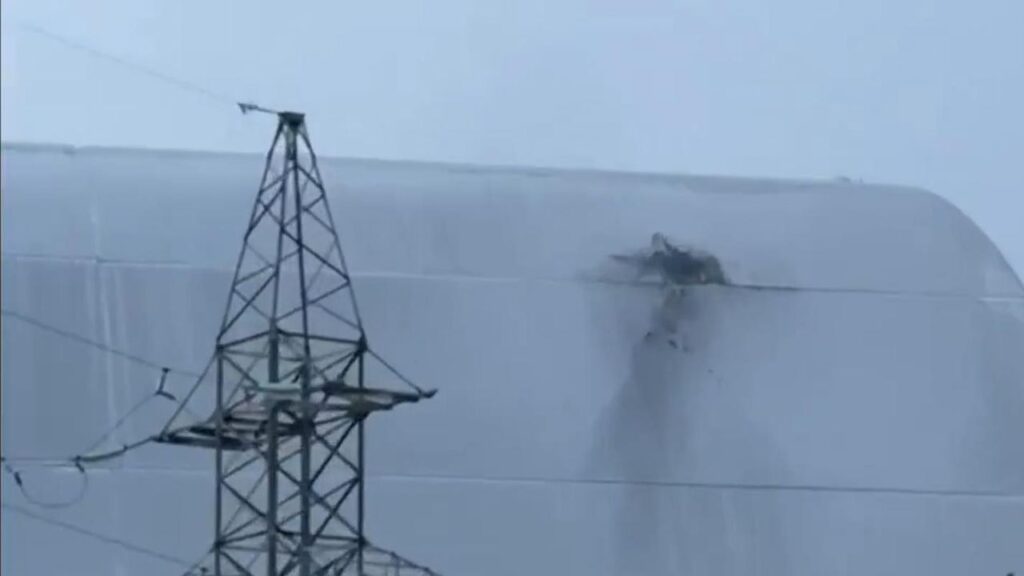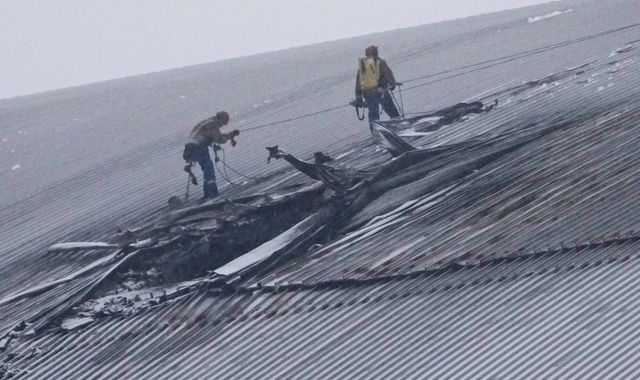Explore the recent incident where a Russian drone penetrated Chernobyl’s protective shield, igniting a fire and raising concerns about safety and security.
Introduction
A suspected Russian drone attack has reportedly breached the protective shield of the Chernobyl Nuclear Power Plant, sparking a fire and raising concerns over potential radiation risks in the area. Ukrainian officials have condemned the strike, calling it an act of “nuclear terrorism” that threatens not just Ukraine but the entire world.
Drone Attack on Chernobyl.Terrifying

According to https://www.giggle.ink/news/Ukrainian authorities, the drone struck a section of the protective dome covering the remains of Reactor No. 4, the site of the catastrophic 1986 nuclear disaster. The impact created a hole in the structure, which is designed to contain radioactive materials and prevent their release into the environment. The attack also ignited a fire in nearby facilities, prompting an emergency response from fire crews and security forces.
The State Agency of Ukraine for Exclusion Zone Management confirmed the incident, stating that radiation levels in the area are being closely monitored. “This reckless attack on one of the world’s most dangerous nuclear sites is unacceptable. We are assessing the extent of the damage and taking immediate measures to prevent further risks,” an official spokesperson said.
Rising Fears of Radiation Leakage
Although initial reports indicate no immediate rise in radiation levels, experts warn that damage to the protective shield could pose a serious threat if left unaddressed. The protective structure, known as the New Safe Confinement, was completed in 2016 with international funding to contain radioactive debris and prevent further contamination.
Nuclear energy specialists have expressed concerns about potential long-term consequences. “Any damage to the integrity of the confinement structure increases the risk of radioactive material escaping into the environment. Even if the radiation levels remain stable now, we must act swiftly to repair the damage and ensure long-term safety,” said Dr. Oleksandr Petrov, a nuclear physicist based in Kyiv.
Ukraine Blames Russia for ‘Nuclear Terrorism’
Ukrainian President Volodymyr Zelenskyy strongly condemned the attack, calling it an example of Russia’s disregard for global nuclear safety. “This is not just an attack on Ukraine; this is an attack on the entire world. Chernobyl is a ticking time bomb, and any reckless actions near this site could lead to a disaster far worse than what we experienced in 1986,” Zelenskyy said in a televised address.https://edition.cnn.com/
Ukrainian intelligence agencies believe the drone was launched by Russian forces as part of their ongoing military campaign against Ukraine. The government has called for an urgent response from international organizations, including the United Nations and the International Atomic Energy Agency (IAEA), to address the security threats posed by Russian attacks on nuclear infrastructure.
Russia Denies Involvement
In response to Ukraine’s accusations, Russian officials have denied any involvement in the drone strike. The Russian Defense Ministry dismissed the claims as “Ukrainian propaganda,” stating that Moscow has no interest in targeting nuclear facilities.
However, Ukraine has previously accused Russia of attacking critical energy and nuclear infrastructure, including strikes on the Zaporizhzhia Nuclear Power Plant, the largest nuclear facility in Europe, which has been under Russian control since early in the war.
Global Reaction and Concerns
The attack has sparked international condemnation, with world leaders urging Russia to refrain from targeting sensitive sites. NATO Secretary-General Jens Stoltenberg expressed deep concern over the incident, calling for immediate protective measures. “An attack on a nuclear site is an act of extreme recklessness. Russia must be held accountable for endangering global security,” Stoltenberg said.
The United Nations has called for an emergency meeting to discuss the risks posed by military actions near nuclear sites, while the European Union is considering imposing further sanctions on Russia for its alleged role in the attack.
Impact on the Exclusion Zone and Surrounding Areas
The Chernobyl Exclusion Zone, a highly contaminated area covering approximately 2,600 square kilometers, remains largely uninhabited due to radiation risks. The protective shield, along with other safety measures, has played a crucial role in keeping radioactive materials contained. Any structural damage could reverse decades of decontamination efforts.
Local authorities have increased security measures in and around the Exclusion Zone to prevent further attacks. Emergency crews are working to repair the damage, and additional radiation monitoring stations have been deployed to detect any potential leaks.
What Happens Next?
Ukrainian officials have vowed to strengthen the protection of critical infrastructure, including nuclear sites. The government is urging international allies to provide advanced air defense systems to prevent further attacks.
Meanwhile, experts warn that as long as the war continues, the risk of another attack on nuclear facilities remains high. The IAEA has reiterated its call for all parties to respect nuclear safety protocols and avoid actions that could lead to catastrophic consequences.
As investigations into the attack continue, the world watches anxiously, hoping that the situation does not escalate into another nuclear crisis.
Conclusion
The drone strike on Chernobyl’s protective shield is a stark reminder of the ongoing dangers posed by the war in Ukraine. With global security at stake, world leaders must take decisive action to prevent further threats to nuclear facilities. If left unchecked, such attacks could lead to consequences far worse than the world has seen before.
What was the light above Chernobyl?
Cherenkov radiation is a form of energy that we can perceive as a blue glow emitted when the electrically charged particles that compose atoms (i.e. electrons and protons) are moving at speeds faster than that of light in a specific medium.
Was Chernobyl the worst nuclear disaster in history?
It was the worst nuclear disaster in history, releasing more than 400 times as much radioactive material as the Hiroshima atomic bomb. An uncontrollable chain reaction inside the reactor caused a sharp increase in temperature that ultimately resulted in the fusion of the fuel rods, a steam explosion and a fire.

